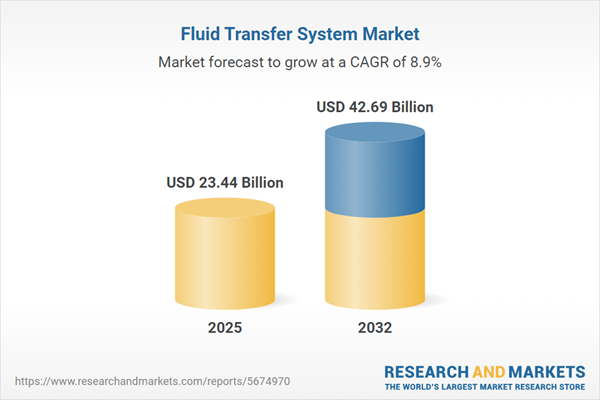Speak directly to the analyst to clarify any post sales queries you may have.
Senior executives in the fluid transfer system sector are navigating increasing regulatory demands, shifting priorities, and continuous technological change. Comprehensive, decision-focused insights are essential to understanding market direction and anticipating opportunities and challenges in this evolving landscape.
Market Snapshot: Fluid Transfer System Market Trends and Growth
The global fluid transfer system market is valued at USD 21.53 billion in 2024, with projected growth to USD 23.44 billion by 2025 and USD 42.69 billion by 2032. This expansion, reflected by a CAGR of 8.92%, is grounded in rapid industrial automation and accelerating digital transformation. Companies in manufacturing, processing, and infrastructure increasingly prioritize systems that are reliable, efficient, and compliant. In today’s environment, a focus on operational agility and the ability to adapt to changing compliance standards drive organizations to modernize fluid transfer infrastructure and secure their competitive positioning.
Scope & Segmentation of the Fluid Transfer System Market
- Product Types: Fittings, hoses, pumps, tubings, and valves address specific technical requirements in diverse industry applications, enabling tailored solutions to increase productivity and system reliability.
- End User Industries: Sectors such as chemical processing, food and beverage, oil and gas, pharmaceuticals, biotechnology, and water management rely on customized fluid transfer solutions engineered to meet sector-specific safety standards and compliance requirements.
- Material Types: Polyethylene, polypropylene, PTFE, advanced rubber compounds, and stainless steel enhance durability, support chemical resistance, and uphold product integrity across various media and operational demands.
- Flow Rate Categories: High, medium, and low flow systems serve a range of processing environments, supporting needs from batch to continuous operations and facilitating precise adjustments in line with demand cycles or production shifts.
- Regional Markets: The Americas, Europe, Middle East and Africa, and Asia-Pacific present differing regulatory landscapes, investment levels, and digital adoption rates, prompting the need for market-specific strategies and solution localization.
- Key Companies: Leading organizations, including Parker-Hannifin Corporation, Danfoss A/S, Eaton Corporation plc, Flowserve Corporation, Sulzer Ltd, Alfa Laval AB, Xylem Inc., Grundfos Holding A/S, SPX Flow, Inc., and IDEX Corporation, shape technological advancement and address increasing complexity within the sector.
Key Takeaways for Senior Decision-Makers
- Digital monitoring and intelligent sensor integration yield actionable process visibility, allowing proactive maintenance to address inefficiencies and address operational risk at an early stage.
- Sustainable material choices, including recyclable polymers and composites, can enhance environmental compliance and improve overall system longevity in high-demand scenarios.
- Consistent quality in system components is fundamental for minimizing compliance risks and protecting workforce safety, especially in sectors governed by stringent operational controls.
- Resilient supplier relationships and agile procurement strategies minimize exposure to supply chain volatility or sudden regulatory adjustments.
- Collaboration with technology and manufacturing partners accelerates response to evolving standards and enables quicker implementation of innovative system upgrades.
Tariff Impact on Supply Chains
Recent changes in U.S. tariff policies affect the costs of steel, aluminum, and electronics used in fluid transfer systems. These shifts prompt organizations to diversify suppliers, leverage analytics for enhanced supply chain resilience, and modify procurement approaches to maintain margin stability and ensure continued operational reliability amid fluctuating regulatory frameworks.
Methodology & Data Sources
This analysis is built on direct interviews with stakeholders, a review of technical documents, corporate reporting, and supply chain data. Subject-matter expertise is leveraged to align insights with the strategic objectives and risk thresholds facing executive leadership in this space.
Why This Report Matters for Industry Leaders
- Clear segmentation and actionable analysis support organizations in targeting growth areas amid changing market and regulatory conditions.
- Enhanced planning and risk management tools help anticipate shifts in compliance, enabling more agile adaptation to new requirements.
- The report equips leaders with practical recommendations for adopting new materials and digital tools to secure competitive advantage regionally and globally.
Conclusion
Leaders can apply these insights to refine strategies, ensuring their organizations remain agile as fluid transfer systems increase in complexity. Proactive adaptation supports continued operational strength and sound investment decisions.
Additional Product Information:
- Purchase of this report includes 1 year online access with quarterly updates.
- This report can be updated on request. Please contact our Customer Experience team using the Ask a Question widget on our website.
Table of Contents
3. Executive Summary
4. Market Overview
7. Cumulative Impact of Artificial Intelligence 2025
Companies Mentioned
The companies profiled in this Fluid Transfer System market report include:- Parker-Hannifin Corporation
- Danfoss A/S
- Eaton Corporation plc
- Flowserve Corporation
- Sulzer Ltd
- Alfa Laval AB
- Xylem Inc.
- Grundfos Holding A/S
- SPX Flow, Inc.
- IDEX Corporation
Table Information
| Report Attribute | Details |
|---|---|
| No. of Pages | 187 |
| Published | October 2025 |
| Forecast Period | 2025 - 2032 |
| Estimated Market Value ( USD | $ 23.44 Billion |
| Forecasted Market Value ( USD | $ 42.69 Billion |
| Compound Annual Growth Rate | 8.9% |
| Regions Covered | Global |
| No. of Companies Mentioned | 11 |









